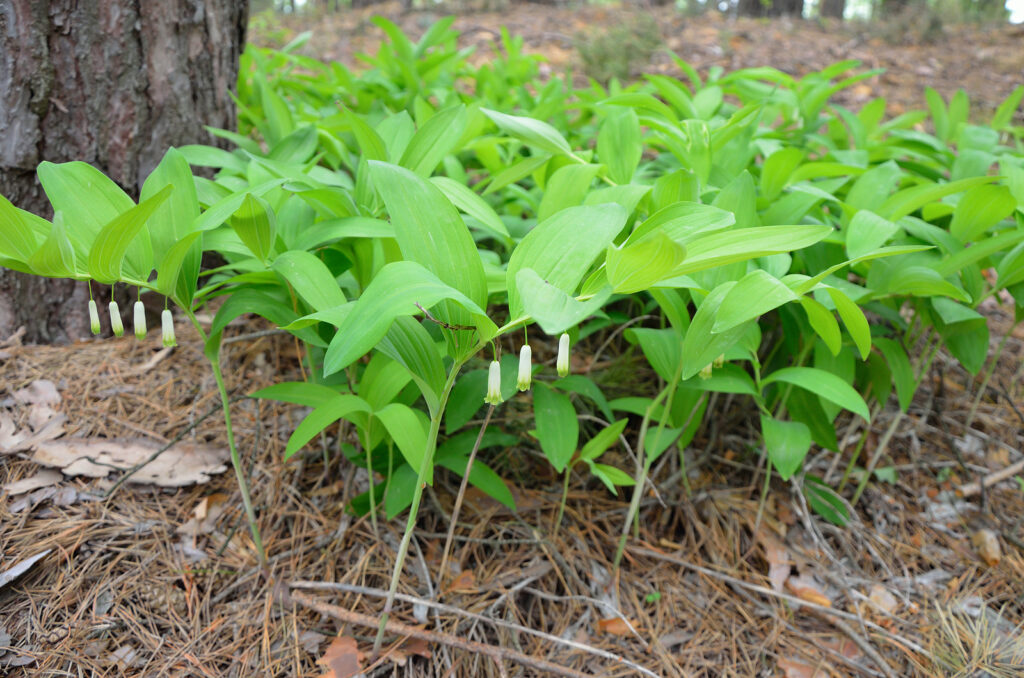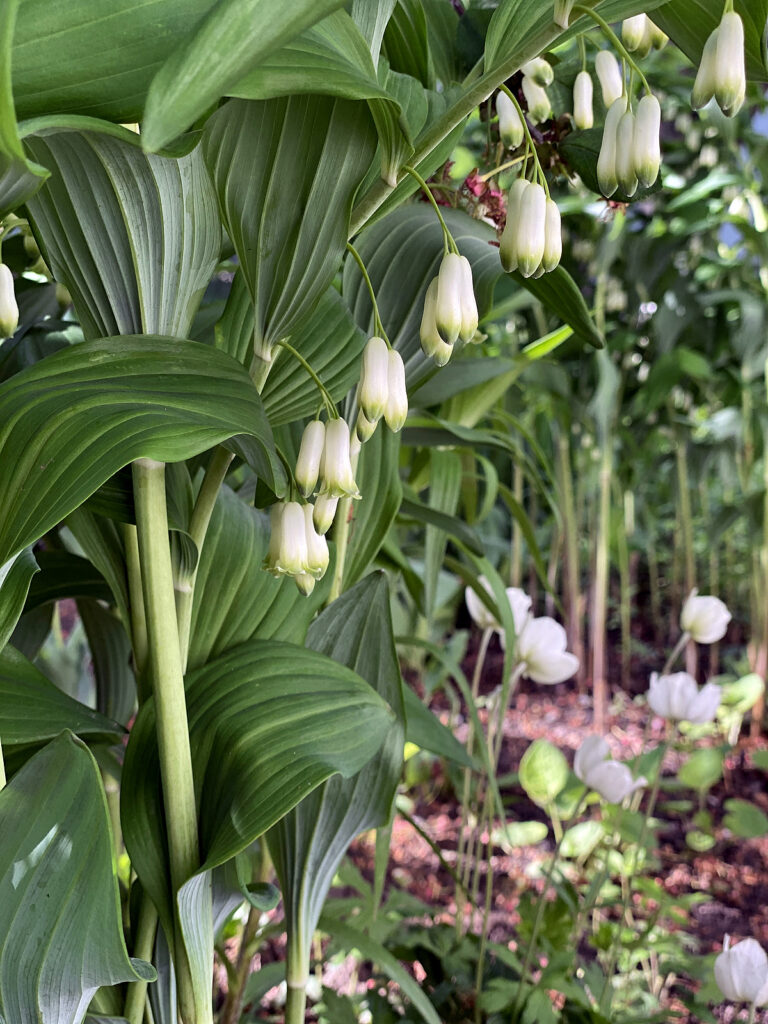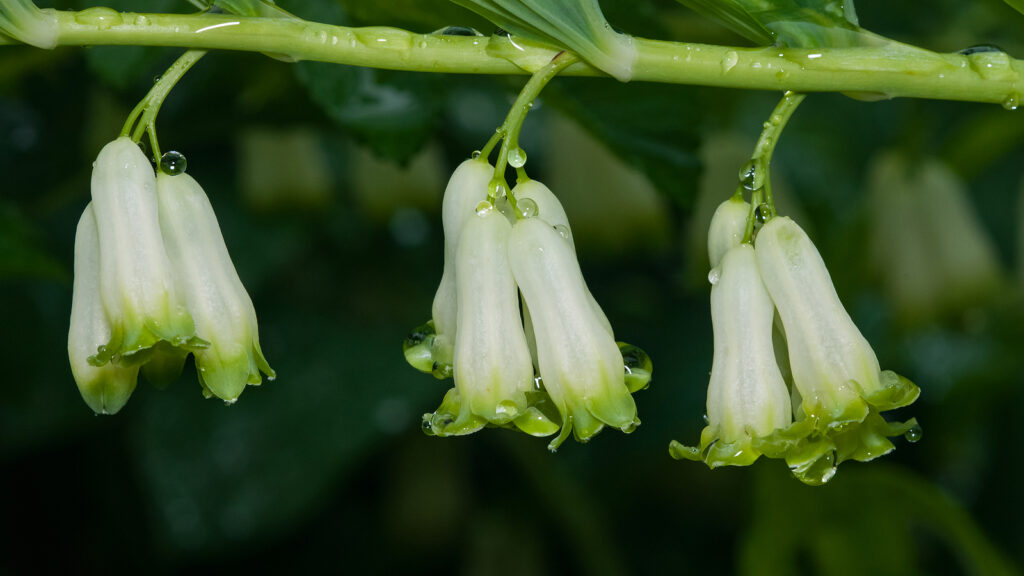Polygonatum – commonly called Solomon’s seal–is a perennial grown for foliage and flowers. Polygonatum have whorled linear to broadly ovate, parallel-veined leaves that turn yellow in autumn. Mostly pendent, sometimes erect, tubular to bell-shaped white, cream, and occasionally purple-pink flowers with green markings are either solitary or borne in small clusters. Flowers hang beneath stems on threadlike stalks in spring.
Polygonatum flowers are often followed by berry-like, spherical red or black fruits. Leaves and stems die to the ground in autumn.
Polygonatum is suited for a shady mixed or herbaceous border, or for a woodland or rock garden. Polygonatum is attractive in containers.
Polygonatum is a genus of about 50 species of rhizomatous perennials. Polygonatum is native to woodlands in temperature regions of North American and Eurasia.

Get to know Polygonatum
- Plant type: Rhizomatous perennials
- Growing zones and range: Zones 3 to 9
- Hardiness: Hardty to -30°F (-34°C)
- Height and width: Varies
- Growth rate: Slow to moderate, spread steadily
- Form and habit: Spreading, upright and then bend outward
- Foliage: Usually arching stems and alternate, opposite, or whorled, linear to broadly elliptic or ovate, parallel-veined leaves that turn yellow in autumn
- Flowers: Mostly pendent, sometimes erect, tubular to bell-shaped are either solitary or borne in small clusters, often along the lower sides of the stems
- Flower colors: Mainly white or cream, occasionally purple-pink, with green markings
- Bloom time: Spring
- Fruits: Berry-like, spherical, red or black fruits
- Uses: Shady mixed border, woodland or rock garden
- Garden companions: Good with astilbe, ferns, hellebore, hosta, wild ginger, mounded hosta, lungwort, cranesbill, purple-leaf coral bells, heart-leaf brunnera, and bleeding heart
- Common name: Soloman’s seal
- Botanical name: Polygonatum
- Family name: Liliaceae
- Origin: Eurasia and North America
Where to plant Polygonatum
- Plant Polygonatum in full sun or partial shade; Polygonatum tolerate full sun in northern zones, but require shade during the hottest part of the day in the South.
- Plant Polygonatum in fertile, humus-rich, moist but well-drained soil; need loose, woodsy soil.
Polygonatum uses and companions
- Grow Polygonatum in a shady mixed or herbaceous border or in a woodland or rock garden.
- Good garden companions for Polygonatum include Alchemilla mollis, Astilbe, Bergenia, Epimedium, Helleborus, Hosta, Liriope.
When to plant Polygonatum
- Sow Polygonatum seed in containers in a cold frame in autumn.

Planting and spacing Polygonatum
- Buy the largest container plant you can find; small Polygonatum are slow to develop a strong presence in the garden.
- Plant most Polygonatum 10-12 inches (25-30cm) apart.
How to water and feed Polygonatum
- Give Polygonatum regular water.
- Feed Polygonatum with an all-purpose organic fertilizer in spring.
How to care for Polygonatum
- Polygonatum is likely to go dormant early.
- Deadheading does not prolong or stimulate bloom; it ruins the plant’s profile instead.
- Do not cut plants back as foliage and stems decompose quickly in winter.
Polygonatum pests and diseases
- Polygonatum is susceptible to attacks by slugs, snails, and sawfly larvae.
- Scorch may occur on foliage exposed to heat, drought, or full sun.
Polygonatum propagation
- Divide Polygonatum rhizomes when growth begins in spring, taking care to avoid damaging young, brittle shoots, or divide in autumn.
- Rarely need dividing; to get more plants, remove rhizomes from a clump’s edge in early spring.
- Divide every five to six years in fall or spring; plants have offsets and are easy to move.
- Polygonatum can be grown from seed, but germination can take up to a year.

Phormium varieties to grow
- Polygonatum biflorum, Small Solomon’s seal, rhizomatous perennial with arching, hairless stems bearing alternate, narrowly lance-shaped to broadly, elliptic leaves, to 7 inches (18cm) long, with hairless or minutely hairy undersides that are glaucous along the veins. From late spring to midsummer, usually solitary or 2-4 pendent, tubular, greenish-white flowers, .5-1 inch (1-2.5cm) long, are produced in the leaf axils; they are followed by spherical black fruit, .4 inch (9mm) across. To 16-72 inches (.4-2m) tall and 24 inches (60cm) wide. South Central Canada, East North America. Zones 3 to 9.
- P. commutatum, carries 7-inch (2m) leaves on stems normally reaching 4-5 feet (1.2-1.5m) high, possibly 7 feet (2m) tall. Flowers in groups of two to ten. This species is considered to be a vigorous form of P. biflorum. It is sometimes sold as P. canadiculatum.
- P. odoratum, Flagrant Solomon’s seal, creeping, rhizomatous perennial with arching, angular stems bearing alternate, lance-shaped to ovate, hairless leaves, 2-6 inches (5-15cm) long, usually in 2 rows. In late spring and early summer, 1 or 2 pendent, tubular, fragrant, green-tipped white flowers, to 1.3 inches (3cm) long, are borne in the upper leaf axils, followed by spherical black fruit, .3 inch (6mm) across. To 34 inches (85cm) tall and 12 inches (30cm) wide. Europe, Caucasus, Russia (Siberia) to Japan. Zones 4 to 8.
- P. verticillatum, Whorled Solomon’s seal, rhizomatous perennial with erect, slightly angular, hairless stems bearing stalkless, mainly whorled, sometimes opposite, lance-shaped leaves, 2.5-6 inches (6-15cm) long. From late spring to midsummer, produces 1-4 pendent, tubular, greenish-white flowers, to .5 inch (1.5cm) long, in the upper leaf axils; they are followed by spherical red fruit, .3 inch (6mm) across. To 8-36 inches (20-90cm) tall and 10 inches (25cm) wide. Europe, Caucasus, Afghanistan.















